Related Research Articles
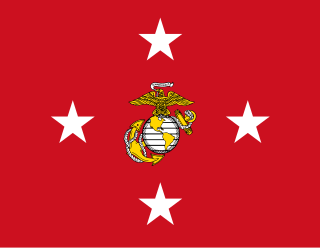
The commandant of the Marine Corps (CMC) is normally the highest-ranking officer in the United States Marine Corps and is a member of the Joint Chiefs of Staff. The CMC reports directly to the secretary of the Navy and is responsible for ensuring the organization, policy, plans, and programs for the Marine Corps as well as advising the president, the secretary of defense, the National Security Council, the Homeland Security Council, and the secretary of the Navy on matters involving the Marine Corps. Under the authority of the secretary of the Navy, the CMC designates Marine personnel and resources to the commanders of Unified Combatant Commands. The commandant performs all other functions prescribed in Section 5043 in Title 10 of the United States Code or delegates those duties and responsibilities to other officers in his administration in his name. As with the other joint chiefs, the commandant is an administrative position and has no operational command authority over United States Marine Corps forces.
The United States Armed Forces are the military forces of the United States of America. It consists of the Army, Marine Corps, Navy, Air Force, Space Force, and Coast Guard. The president of the United States is the commander-in-chief of the Armed Forces and forms military policy with the Department of Defense (DoD) and Department of Homeland Security (DHS), both federal executive departments, acting as the principal organs by which military policy is carried out. All six armed services are among the eight uniformed services of the United States.

The secretary of the Navy is a statutory officer and the head of the Department of the Navy, a military department within the United States Department of Defense.

Michael William Hagee is a retired United States Marine Corps four-star general who served as the 33rd Commandant of the Marine Corps from 2003 to 2006, succeeding General James L. Jones on January 13, 2003. He stepped down as Commandant two months before the end of his four-year term, and was succeeded by General James T. Conway on November 13, 2006. On that date, Hagee had his retirement ceremony just prior to the passage of command ceremony. Hagee retired from the Marine Corps on January 1, 2007.
The United States service academies, also known as the United States military academies, are federal academies for the undergraduate education and training of commissioned officers for the United States Armed Forces.

Ben Hebard Fuller was a major general in the United States Marine Corps and served as the 15th Commandant of the Marine Corps between 1930 and 1934.

The United States Department of the Navy (DN) is one of the three military departments within the Department of Defense of the United States of America. The Department of the Navy was established by an Act of Congress on 30 April 1798, to provide a government organizational structure to the United States Navy (USN), the United States Marine Corps (USMC) and, when directed by the President, the United States Coast Guard (USCG), as a service within the Department of the Navy, though each remain independent service branches.
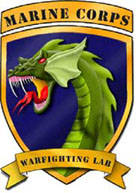
The United States Marine Corps Warfighting Laboratory (MCWL) was established in 1995, at Marine Corps Base Quantico, Virginia. The organization was originally known as the Commandant's Warfighting Laboratory. The battle lab is part of Combat Development and Integration--under Headquarters, United States Marine Corps--and its stated purpose is to improve current and future naval expeditionary warfare capabilities across the spectrum of conflict for current and future operating forces.
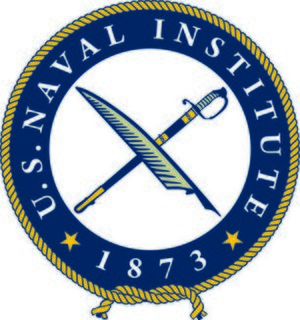
The United States Naval Institute (USNI), based in Annapolis, Maryland, is a private, non-profit, professional military association that seeks to offer independent, nonpartisan forums for debate of national defense and security issues. In addition to publishing magazines and books, the Naval Institute holds several annual conferences.

The Dental Corps of the United States Navy consists of naval officers who have a doctorate in either dental surgery (DDS) or dental medicine (DMD) and who practice dentistry for Sailors and Marines to ensure optimal oral health.
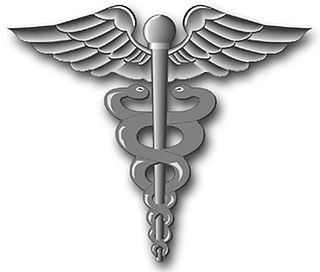
A hospital corpsman is an enlisted medical specialist of the United States Navy, who may also serve in a U.S. Marine Corps unit. The corresponding rating within the United States Coast Guard is health services technician (HS).
USS Scott (DE-214), a Buckley-class destroyer escort of the United States Navy, was named in honor of Machinist's Mate First Class Robert R. Scott (1915–1941, who was killed in action during the Japanese attack on Pearl Harbor on 7 December 1941, while serving aboard the battleship USS California. He was posthumously awarded the Medal of Honor for his heroism.
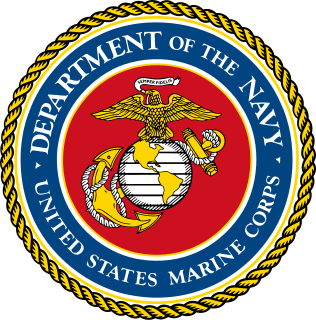
Headquarters Marine Corps (HQMC) is a headquarters staff within the Department of the Navy which includes the offices of the Commandant of the Marine Corps, the Assistant Commandant of the Marine Corps and various staff functions. The function, composition, and general duties of HQMC are defined in Title 10 of the United States Code, Subtitle C, Part I, Chapter 506.

The history of the United States Marine Corps (USMC) begins with the founding of the Continental Marines on 10 November 1775 to conduct ship-to-ship fighting, provide shipboard security and discipline enforcement, and assist in landing forces. Its mission evolved with changing military doctrine and foreign policy of the United States. Owing to the availability of Marine forces at sea, the United States Marine Corps has served in nearly every conflict in United States history. It attained prominence when its theories and practice of amphibious warfare proved prescient, and ultimately formed a cornerstone of U.S. strategy in the Pacific Theater of World War II. By the early 20th century, the Marine Corps would become one of the dominant theorists and practitioners of amphibious warfare. Its ability to rapidly respond on short notice to expeditionary crises has made and continues to make it an important tool for U.S. foreign policy.

The United States Fleet Marine Forces (FMF) are combined general- and special-purpose forces within the United States Department of the Navy that perform offensive amphibious or expeditionary warfare and defensive maritime employment. The Fleet Marine Forces provide the National Command Authority (NCA) with a responsive force that can conduct operations in any spectrum of conflict around the globe.
The structure of the United States Navy consists of four main bodies: the Office of the Secretary of the Navy, the Office of the Chief of Naval Operations, the operating forces, and the Shore Establishment.

The United States Marine Corps (USMC), also referred to as the United States Marines, is the maritime land force service branch of the United States Armed Forces responsible for conducting expeditionary and amphibious operations through combined arms, implementing its own infantry, armor, artillery, aerial and special operations forces. The U.S. Marine Corps is one of the eight uniformed services of the United States.
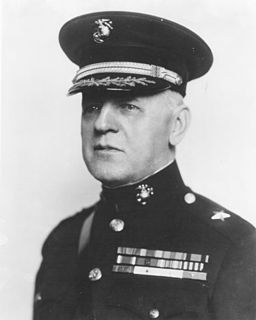
Brigadier General Dion Williams was an officer in the United States Marine Corps. He was the Assistant Commandant of the Marine Corps from August 1, 1925 – July 1, 1928. During his early career, Williams pioneered the first conceptual study of amphibious reconnaissance in the United States and becoming one of the strongest advocates in having the Marine Corps assume the amphibious, expeditionary role. During his career, he fought guerrillas in the Philippines and Dominican Republic during the Spanish–American War.

The United States Navy (USN) is the maritime service branch of the United States Armed Forces and one of the eight uniformed services of the United States. It is the largest and most powerful navy in the world, with the estimated tonnage of its active battle fleet alone exceeding the next 13 navies combined, including 11 U.S. allies or partner nations. It has the highest combined battle fleet tonnage and the world's largest aircraft carrier fleet, with eleven in service, two new carriers under construction, and five other carriers planned. With 336,978 personnel on active duty and 101,583 in the Ready Reserve, the U.S. Navy is the third largest of the U.S. military service branches in terms of personnel. It has 290 deployable combat vessels and more than 3,700 operational aircraft as of June 2019.
References
- This article incorporates text from the public domain Dictionary of American Naval Fighting Ships .The entry can be found here.